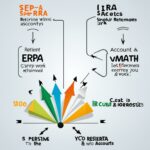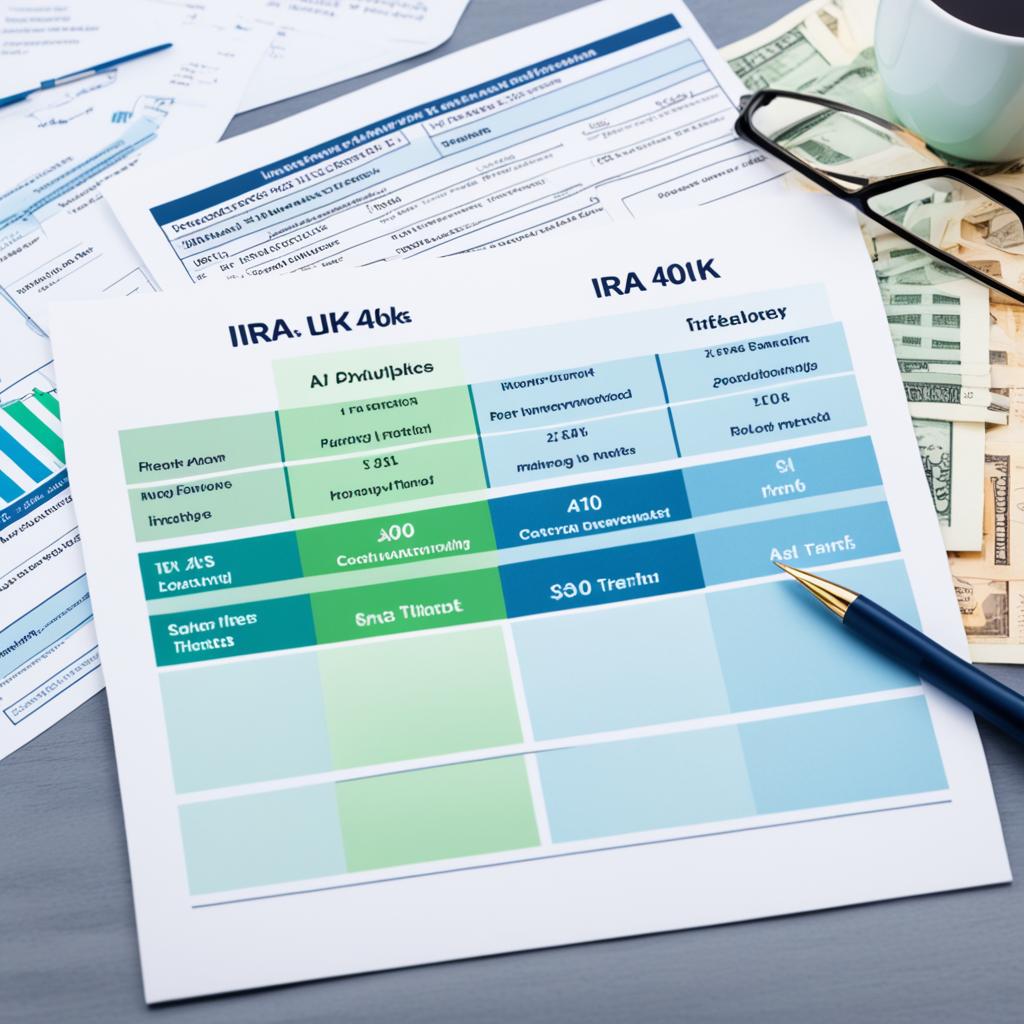When it comes to planning for retirement, it’s important to make informed decisions about your financial future. Two popular options to consider are Individual Retirement Accounts (IRAs) and 401(k) plans. Understanding the differences between these retirement plans can help you determine which one is the best fit for your needs.
IRAs and 401(k)s both offer valuable tax benefits and can help you save for retirement, but there are important distinctions to consider. While 401(k)s are offered through employers, IRAs can be opened individually through a broker or bank. This fundamental difference impacts factors like contribution limits and withdrawal rules.
In this article, I will explore the key differences between IRAs and 401(k)s, including tax benefits, contribution limits, investment options, and more. By the end, you’ll have a better understanding of these retirement plans and be equipped to make an informed decision about which one is right for you.
Key Takeaways:
- IRAs and 401(k)s are retirement plans with valuable tax benefits.
- 401(k)s are employer-sponsored plans, while IRAs can be opened individually.
- Contribution limits and withdrawal rules vary between IRAs and 401(k)s.
- IRAs typically offer more investment options compared to 401(k)s.
- Employer matches are a significant benefit of participating in a 401(k) plan.
Key Differences Between 401(k)s and IRAs
When it comes to retirement planning, understanding the differences between 401(k)s and IRAs is essential. While both options offer tax benefits and serve as valuable tools for saving for retirement, there are some key distinctions that individuals should be aware of.
The Nature of the Plans
One of the primary discrepancies between 401(k)s and IRAs is the way in which they are established. A 401(k) is an employer-sponsored retirement plan, meaning it is provided by your employer. On the other hand, an IRA (Individual Retirement Account) is opened by an individual through a broker or bank.
Investment Options
Another difference lies in the investment options available. While 401(k)s typically offer a limited selection of investment options, such as mutual funds, IRAs tend to provide a broader range of choices, including stocks, bonds, mutual funds, and exchange-traded funds (ETFs). This allows individuals more flexibility in designing their investment portfolio.
Contribution Limits and Employer Match
Contribution limits for 401(k)s and IRAs also differ. In 2024, the contribution limit for a 401(k) is $23,000, whereas an IRA has a contribution limit of $7,000. Additionally, those aged 50 and older can make catch-up contributions to both plans. It’s important to note that employer match options may vary between 401(k)s and IRAs. Many employers offer a matching contribution for 401(k) plans, whereas there is no employer match for IRAs.
Comparison Table: 401(k)s vs IRAs
| Feature | 401(k) | IRA |
|---|---|---|
| Plan Sponsorship | Employer-sponsored | Individual |
| Investment Options | Limited | Wide range |
| Contribution Limit (2024) | $23,000 | $7,000 |
| Catch-Up Contributions | $7,500 for age 50 and older | $1,000 for age 50 and older |
| Employer Match | Often available | Not available |
Ultimately, the choice between a 401(k) and an IRA will depend on individual circumstances and goals. It’s important to consider factors such as employer match, investment options, contribution limits, and tax implications when making this decision. Consulting with a financial advisor can provide personalized guidance and ensure that you choose the retirement plan that best aligns with your needs.
Contribution Limits for IRAs and 401(k)s
When it comes to retirement savings, understanding the contribution limits for IRAs and 401(k)s is crucial. These limits determine how much you can contribute to your retirement accounts each year. Let’s take a closer look at the annual contribution limits for both IRAs and 401(k)s, as well as the catch-up contributions available for individuals aged 50 and older.
Contribution Limits for 401(k)s
The annual contribution limit for 401(k)s in 2024 is $23,000. This means that you can contribute up to $23,000 of your pre-tax income to your 401(k) account each year. It’s important to note that this limit applies to both employee contributions and any employer matching contributions combined.
If you’re aged 50 or older, there is an additional catch-up contribution available. The catch-up contribution for 401(k)s in 2024 is $7,500. This means that individuals aged 50 and older can contribute a total of $30,500 to their 401(k) accounts each year, including both the annual contribution limit and the catch-up contribution.
Contribution Limits for IRAs
The annual contribution limit for IRAs in 2024 is $7,000. This applies to both traditional IRAs and Roth IRAs. It’s important to note that this limit applies to the total combined contributions to all of your IRAs in a given year.
Similar to 401(k)s, individuals aged 50 and older have an additional catch-up contribution available for IRAs. The catch-up contribution for IRAs in 2024 is $1,000. This means that individuals aged 50 and older can contribute a total of $8,000 to their IRAs each year, including both the annual contribution limit and the catch-up contribution.
| Retirement Account | Annual Contribution Limit | Catch-Up Contribution (age 50 and older) |
|---|---|---|
| 401(k) | $23,000 | $7,500 |
| IRAs | $7,000 | $1,000 |
It’s important to keep these contribution limits in mind when planning your retirement savings strategy. By staying within the limits and taking advantage of any catch-up contributions available, you can maximize your retirement savings potential.
Tax Benefits of IRAs and 401(k)s
When it comes to planning for retirement, understanding the tax benefits of different retirement accounts is crucial. Both IRAs and 401(k)s offer valuable tax advantages that can help you maximize your savings potential. Let’s take a closer look at the tax implications of these retirement plans.
Tax-Deferred Growth
One of the key tax benefits of IRAs and 401(k)s is tax-deferred growth. This means that any investment earnings within these accounts are not subject to annual income tax. Instead, your investments can grow on a tax-deferred basis, allowing you to potentially accumulate more over time. This can be especially beneficial for long-term investors who want to take advantage of compound growth.
Tax Deductions for Contributions
Another advantage of traditional IRAs and 401(k)s is the ability to deduct your contributions from your taxable income. By contributing to a traditional IRA or a 401(k), you can reduce your taxable income for the year in which you make the contribution. This can result in immediate tax savings, putting more money back in your pocket.
Tax-Free Withdrawals (Roth Accounts)
Roth IRAs and Roth 401(k)s offer a different tax benefit – tax-free withdrawals in retirement. Unlike traditional accounts where contributions are tax-deductible, Roth accounts use after-tax contributions. As a result, qualified withdrawals from Roth accounts, including both contributions and earnings, are tax-free. This can provide greater flexibility and tax efficiency in retirement.
An Illustration of the Tax Benefits
| Traditional IRA/401(k) | Roth IRA/401(k) | |
|---|---|---|
| Tax Deductibility of Contributions | Contributions are tax-deductible | Contributions are not tax-deductible |
| Tax-Deferred Growth | Earnings grow tax-deferred | Earnings grow tax-free |
| Taxation of Withdrawals | Withdrawals are taxed as ordinary income | Qualified withdrawals are tax-free |
By considering these tax implications, you can make informed decisions about which retirement account is most suitable for your financial goals and circumstances. Keep in mind that everyone’s tax situation is unique, so it’s always a good idea to consult with a financial advisor or tax professional to determine the best strategy for your retirement savings.
Investment Options for IRAs and 401(k)s
When it comes to investment options, IRAs and 401(k)s offer distinct choices that cater to different investment preferences and strategies. Understanding the differences between the two can help you make informed decisions about where to invest your retirement savings.
IRAs:
Individual Retirement Accounts (IRAs) typically provide a wider range of investment options compared to 401(k)s. This flexibility allows investors to customize their portfolios to align with their risk tolerance, retirement goals, and personal investment preferences.
Here are some common investment options available within an IRA:
- Stocks: Investing in individual company stocks allows you to directly own shares and potentially benefit from capital appreciation and dividends.
- Bonds: Bonds are fixed-income securities that pay interest regularly and return the principal at maturity, providing a predictable income stream.
- Mutual Funds: These professionally managed investment funds pool money from multiple investors to invest in diverse portfolios of stocks, bonds, or other assets.
- Exchange-Traded Funds (ETFs): Like mutual funds, ETFs offer diversified investment options but trade on stock exchanges like individual stocks.
- Real Estate Investment Trusts (REITs): REITs allow investors to participate in real estate asset ownership without directly owning properties.
- Commodities: Investing in commodities like gold, oil, or agricultural products can serve as a hedge against inflation and provide diversification.
401(k)s:
401(k) plans, on the other hand, often have a pre-selected list of investment options provided by the employer or plan administrator. These options typically consist of mutual funds that cover a range of asset classes and investment styles.
Here are some common investment options available within a 401(k):
- Mutual Funds: These funds consist of professionally managed portfolios that pool money from multiple investors and invest in various assets.
- Target-Date Funds: These funds automatically adjust the asset allocation based on the investor’s target retirement date, becoming more conservative as the target date approaches.
- Index Funds: Index funds replicate the performance of a specific market index, offering broad exposure to a particular segment of the market.
- Stable Value Funds: These fixed-income options provide a stable return and are typically backed by contracts with insurance companies.
- Company Stock: Some 401(k) plans allow employees to invest in the company’s stock, aligning their retirement savings with their employer’s success.
It’s important to note that the specific investment options available within an IRA or 401(k) can vary depending on the provider or employer. Be sure to review and understand the investment options offered before making any investment decisions.
Ultimately, the choice between an IRA and a 401(k) for investment purposes may depend on your desired level of investment flexibility and access to specific investment options. Consulting with a financial advisor can help you identify the best approach based on your individual circumstances and financial goals.
Employer Match and 401(k) Plans
When it comes to saving for retirement, participating in a 401(k) plan can be a smart choice. One of the key advantages of a 401(k) is the employer match, which can provide a significant boost to your retirement savings.
Many employers offer a matching contribution for 401(k) plans, where they will match a percentage of an employee’s contributions up to a certain limit. For example, if your employer has a 50% match and you contribute 6% of your salary to your 401(k), they will contribute an additional 3% of your salary to your retirement account. This employer match is essentially free money that can help you reach your retirement goals faster.
Let’s say you earn an annual salary of $50,000 and contribute 6% of your salary to your 401(k), which amounts to $3,000. With a 50% employer match, your employer would contribute an additional $1,500 to your retirement account. That’s a total of $4,500 towards your retirement savings, without you having to contribute any extra funds.
The employer match can vary from company to company, so it’s important to check with your employer to understand the specific details of their matching policy. Common match percentages range from 50% to 100% of an employee’s contributions, with limits set on the percentage matched and the maximum dollar amount.
401(k) employer contributions can be a valuable benefit, maximizing your retirement savings potential. It’s a way for your employer to invest in your future and help you build a more secure financial foundation for retirement.
Image:
Tax Treatment of Contributions and Withdrawals
When it comes to retirement savings, understanding the tax treatment of your contributions and withdrawals is crucial. This section will explore the tax implications of traditional IRAs, Roth IRAs, and Roth 401(k)s, offering insights to help you make informed decisions.
Tax Treatment of Traditional IRAs and 401(k)s
Contributions to traditional IRAs and 401(k)s offer immediate tax benefits. When you contribute to these accounts, you can deduct the contributed amount from your taxable income in the year of contribution. This reduces your overall tax liability, potentially putting more money back in your pocket.
“Contributions to traditional IRAs and 401(k)s offer immediate tax benefits, reducing your taxable income in the year of contribution.”
However, it’s important to note that the tax benefits of traditional IRAs and 401(k)s are not permanent. When you make withdrawals from these accounts in retirement, the amounts withdrawn are treated as ordinary income. This means you’ll need to pay income tax on the withdrawn funds, which may be at a different tax rate than when you made the contributions.
Tax Treatment of Roth IRAs and Roth 401(k)s
Roth IRAs and Roth 401(k)s work differently than their traditional counterparts. With these accounts, your contributions are made with after-tax money, meaning you don’t receive an immediate tax deduction.
However, the major advantage of Roth accounts lies in their tax-free growth and tax-free withdrawals in retirement. Any investment earnings within a Roth IRA or Roth 401(k) can grow tax-deferred, and when you withdraw funds in retirement, you won’t owe any additional income tax on those withdrawals.
“Roth IRAs and Roth 401(k)s offer tax-free growth and tax-free withdrawals in retirement, making them attractive options for individuals seeking tax-free income during their golden years.”
This tax-free treatment can provide significant benefits in the long run, especially if you expect your income tax rate to be higher in retirement or if you’re looking for ways to minimize your tax burden during your golden years.
It’s important to consider your current and future tax situation when choosing between traditional and Roth retirement accounts. The right option for you will depend on factors such as your current income, your expected future income, and your overall financial goals and priorities.
| Tax Treatment of Contributions | Tax Treatment of Withdrawals | |
|---|---|---|
| Traditional IRAs and 401(k)s | Tax-deductible | Taxed as ordinary income |
| Roth IRAs and Roth 401(k)s | Not tax-deductible | Tax-free |
Early Withdrawal Rules for IRAs and 401(k)s
Withdrawing money from your IRA or 401(k) before the age of 59½ can result in early withdrawal penalties. It’s important to understand the specific rules and consequences associated with early withdrawals for each type of account. Let’s take a closer look at the withdrawal rules for both IRAs and 401(k)s.
Early Withdrawal Penalty
Both IRAs and 401(k)s impose early withdrawal penalties to discourage individuals from tapping into their retirement savings too soon. The penalty for early withdrawal is generally 10% of the amount withdrawn.
Exceptions to Penalties
However, there are exceptions to these penalties under certain circumstances. Here are some common exceptions for early withdrawals:
- Higher education expenses
- First-time home purchase
- Qualified medical expenses
- Permanent disability
- Substantially equal periodic payments
IRA Withdrawal Rules
When it comes to IRAs, there are additional rules to consider:
- Traditional IRAs: Withdrawals from traditional IRAs are generally subject to income tax. Early withdrawals may incur both income tax and the 10% early withdrawal penalty.
- Roth IRAs: Contributions made to Roth IRAs can be withdrawn at any time without penalty. However, earnings on those contributions may be subject to tax and the early withdrawal penalty if taken before 59½.
401(k) Withdrawal Rules
For 401(k)s, the following rules apply:
- Traditional 401(k)s: Withdrawals from traditional 401(k)s are subject to income tax and the 10% early withdrawal penalty.
- Roth 401(k)s: Contributions made to Roth 401(k)s can be withdrawn at any time without penalty. Like Roth IRAs, earnings on those contributions may be subject to tax and the early withdrawal penalty if taken before 59½.
It’s important to consult with a financial advisor or tax professional to understand the specific rules and implications of early withdrawals for your individual circumstances.
“Early withdrawals from retirement accounts can have significant financial consequences. It’s crucial to consider all the rules and exceptions before making any decisions.”
| Type of Account | Withdrawal Rules | Withdrawal Penalties |
|---|---|---|
| Traditional IRA | Subject to income tax and early withdrawal penalty | 10% penalty |
| Roth IRA | Contributions can be withdrawn penalty-free. Earnings may be subject to tax and penalty | 10% penalty (on earnings only) |
| Traditional 401(k) | Subject to income tax and early withdrawal penalty | 10% penalty |
| Roth 401(k) | Contributions can be withdrawn penalty-free. Earnings may be subject to tax and penalty | 10% penalty (on earnings only) |
Rollover Options for IRAs and 401(k)s
When it comes to managing your retirement accounts, it’s important to understand the rollover options available. Rollovers allow you to transfer funds from one retirement account to another without incurring any tax penalties. In the case of IRAs and 401(k)s, rollovers provide individuals with the flexibility to move money between these two types of accounts. Whether you’re transitioning jobs or simply looking to consolidate your retirement savings, understanding the rollover process is crucial.
For those looking to rollover funds from a 401(k) into an IRA, the process is relatively straightforward. The Internal Revenue Service (IRS) provides guidelines for penalty-free rollovers, ensuring that individuals can make the transfer without incurring any tax liabilities. By initiating a direct transfer, the funds move from the 401(k) directly into the IRA, bypassing any potential tax implications.
Rollovers offer several benefits, including greater control over your retirement savings and expanded investment options. With an IRA, you have the freedom to choose from a wide range of investment vehicles, including stocks, bonds, mutual funds, and ETFs. This flexibility allows you to tailor your investments to align with your financial goals and risk tolerance.
Benefits of Rollovers:
- Consolidation of retirement accounts
- Expanded investment options
- Greater control over your retirement savings
- Opportunity to take advantage of potentially lower fees
It’s important to note that rollovers must be completed within a specific timeframe to avoid any potential tax consequences. Generally, you have 60 days from the date of withdrawal from the original account to complete the rollover. However, it’s always advisable to consult with a financial advisor or tax professional to ensure you adhere to all IRS guidelines and avoid any unintended tax liabilities.
Remember, the key to a successful rollover is to follow the IRS guidelines and initiate a direct transfer. By doing so, you can avoid unnecessary taxes and ensure a seamless transition of your retirement funds.
To illustrate the process, consider the following example:
| Retirement Account | Amount |
|---|---|
| 401(k) | $100,000 |
In this scenario, let’s say I decide to roll over my $100,000 401(k) into an IRA. By following the IRS guidelines, I initiate a direct transfer, and the funds are moved into my IRA without any tax implications.
Lorem ipsum dolor sit amet, consectetur adipiscing elit. Fusce sollicitudin leo in urna auctor, quis hendrerit arcu tincidunt. Curabitur at tortor neque. Nam lobortis tincidunt justo et suscipit. Nullam vel dolor et tellus mattis sagittis ac ut nunc. Mauris turpis ex, tempor et auctor eget, dignissim in orci. Aliquam accumsan venenatis mi ac aliquam. Maecenas sit amet ultrices augue.
With the funds now in my IRA, I have a wider range of investment options at my disposal. I can choose to allocate my savings across various asset classes, diversifying my portfolio and potentially optimizing my investment growth over time.
Overall, rollovers provide individuals with the flexibility to manage their retirement savings effectively. By understanding the process, adhering to IRS guidelines, and seeking professional advice when needed, you can make informed decisions about your IRA and 401(k) rollover options to secure a financially stable retirement.
Choosing Between an IRA and 401(k)
When it comes to deciding between an IRA and a 401(k) for your retirement savings, there are several factors to consider. Evaluating these factors will help you make an informed decision that aligns with your individual circumstances and goals.
Employer Match
One important factor to consider is whether your employer offers a matching contribution for a 401(k) plan. An employer match is essentially free money that can significantly boost your retirement savings. If your employer offers a match, it may be advantageous to take full advantage of this benefit by participating in a 401(k) plan.
Investment Options
Another consideration is the range of investment options available to you. IRAs typically offer a broader selection of investment choices, including stocks, bonds, mutual funds, and exchange-traded funds (ETFs). On the other hand, 401(k) plans may have a limited selection of investment options, mainly consisting of mutual funds pre-selected by your employer.
Contribution Limits
Understanding the contribution limits is crucial when deciding between an IRA and a 401(k). The Internal Revenue Service (IRS) sets annual contribution limits for both types of accounts. In 2024, the maximum contribution limit for 401(k) plans is $23,000, while the limit for IRAs is $7,000. It’s important to evaluate whether these limits align with your desired savings goals.
Tax Implications
Consider the tax implications of each retirement account. Traditional IRAs and 401(k)s offer tax-deductible contributions, meaning you can reduce your taxable income in the year you contribute. However, withdrawals from these accounts in retirement are taxed as ordinary income. In contrast, Roth IRAs and Roth 401(k)s use after-tax contributions, allowing for tax-free withdrawals in retirement.

By carefully considering factors such as employer match, investment options, contribution limits, and tax implications, you can make an informed choice when deciding between an IRA and a 401(k). Your retirement savings strategy should align with your unique circumstances and goals, ensuring a secure financial future.
Benefits of Maxing Out Contributions
When it comes to retirement savings, maxing out contributions to either an Individual Retirement Account (IRA) or a 401(k) can have significant benefits for your financial future.
By taking full advantage of the contribution limits set for these retirement accounts, you can make the most of compound growth and potentially increase your retirement income.
Contributing the maximum allowed amount to your IRA or 401(k) ensures that you are maximizing the potential for your retirement savings to grow over time. The power of compound growth means that your investments can accumulate earnings on top of earnings, creating a snowball effect that can significantly boost your final nest egg.
For example, let’s say you contribute the maximum amount allowed to your retirement account each year, consistently over several decades. By doing so, you give your investments more time to benefit from compound growth, which can result in a substantial increase in your retirement income.
“Maxing out your contributions to an IRA or 401(k) is like giving your retirement savings a turbo boost. It’s a smart move that can make a real difference in providing for your future.”
In addition to the potential for higher retirement income, maxing out contributions can also provide tax advantages. Both IRAs and 401(k)s offer tax benefits, such as tax-deferred growth and potential tax deductions for contributions, depending on the type of account you choose. Consult with a tax professional or financial advisor to better understand the specific tax implications for your situation.
It’s important to note that the contribution limits for IRAs and 401(k)s may change over time due to inflation and other factors. Therefore, it’s a good idea to stay informed about any updates to these limits so you can adjust your contributions accordingly.
By making the commitment to max out your contributions, you are prioritizing your retirement savings and setting yourself up for a more financially secure future. Remember, starting early and consistently contributing to your retirement accounts can have a significant impact on your long-term savings goals.
Stay focused on your retirement goals and take advantage of the benefits that come with maxing out your contributions. Your future self will thank you for it!
Factors to Consider for Non-Matching 401(k)s
If your employer does not offer a matching contribution to your 401(k), it’s important to explore alternative retirement savings options. One option to consider is an Individual Retirement Account (IRA).
IRAs provide a wider range of investment options compared to non-matching 401(k)s. With an IRA, you have the flexibility to choose from various investment vehicles such as stocks, bonds, mutual funds, and exchange-traded funds (ETFs). This allows you to align your investments with your personal financial goals and risk tolerance.
In addition to the investment choices, IRAs often have lower administrative fees compared to 401(k)s. This means more of your money can go towards growing your retirement savings rather than paying fees. It’s important to carefully review the fees associated with any retirement account to maximize your savings.
Another factor to consider is the tax advantages offered by IRAs. Depending on the type of IRA you choose, you can benefit from either tax-deductible contributions or tax-free withdrawals in retirement. Traditional IRAs provide a tax deduction for contributions, while Roth IRAs offer tax-free growth and tax-free withdrawals in retirement.
In summary, when deciding where to save for retirement without a matching 401(k), consider the investment options, administrative fees, and tax advantages provided by an IRA. It’s important to choose a retirement savings option that aligns with your financial goals and provides the best opportunity for long-term growth.
Comparison of Investment Options, Administrative Fees, and Tax Advantages
| Investment Options | Administrative Fees | Tax Advantages | |
|---|---|---|---|
| Non-Matching 401(k) | Limited investment options, mainly mutual funds | May have higher administrative fees | Potential tax deductions for contributions |
| IRA | Wide range of investment options: stocks, bonds, mutual funds, ETFs | Often lower administrative fees | Tax-deductible contributions (Traditional IRA) or tax-free withdrawals (Roth IRA) |
Importance of Starting Early
When it comes to retirement planning, starting early is key. The power of compounding growth can significantly impact your long-term savings, allowing your investments to grow and potentially providing a larger nest egg for retirement.
By starting to save for retirement early, you can take advantage of the time value of money. This concept emphasizes the importance of investing early to maximize the growth of your savings over time.
Let me illustrate the power of compounding growth with an example:
| Scenario | Start Saving at Age 25 | Start Saving at Age 35 | Start Saving at Age 45 |
|---|---|---|---|
| Initial Investment | $10,000 | $10,000 | $10,000 |
| Annual Contribution | $5,000 | $5,000 | $5,000 |
| Investment Return | 7% | 7% | 7% |
| Total Savings at Age 65 | $1,378,785 | $701,703 | $355,071 |
As you can see from the table above, starting to save at age 25 can result in a significantly higher total savings at age 65 compared to starting at age 35 or 45. This is due to the compounding growth of your investments over time.
By starting early, you give your investments more time to grow and benefit from compounding, which is the phenomenon where your investment returns generate additional earnings that are reinvested for further growth.
So, don’t wait until later to begin your retirement savings journey. Start saving early, even if it’s just a small amount. Every dollar saved and invested has the potential to grow and make a meaningful difference in your long-term savings.

Seeking Professional Advice
When it comes to retirement planning, making informed decisions is crucial. That’s where a financial advisor can provide valuable guidance and personalized advice tailored to your specific needs and goals.
A professional financial advisor has a deep understanding of retirement planning strategies and can help you navigate the complex landscape of IRA vs 401(k) decisions. They can assess your individual circumstances, such as your income, tax situation, and retirement goals, to recommend the best course of action.
Retirement planning is not a one-size-fits-all approach, and having a financial advisor by your side ensures that your retirement strategy aligns with your unique situation.
“A good financial advisor can provide you with a comprehensive retirement plan that takes into account your current financial situation, risk tolerance, and long-term goals. They can help you make the right choices when it comes to IRA vs 401(k) contributions and other retirement planning strategies.”
By seeking professional advice, you gain access to expert knowledge and experience that can optimize your retirement savings. A financial advisor can help you assess your risk tolerance, select appropriate investment options, and create a diversified portfolio tailored to your needs.
Furthermore, a financial advisor can monitor your progress, adjust your retirement strategy as needed, and provide ongoing support and guidance. Their expertise can help you stay on track and make necessary adjustments when life circumstances or financial markets change.
Why Choose a Financial Advisor?
Here are a few key reasons why working with a financial advisor can benefit your retirement planning:
- Expertise: A financial advisor specializes in retirement planning and has in-depth knowledge of the intricacies involved.
- Objective Perspective: Advisors can provide an unbiased viewpoint and help you make rational decisions based on your financial goals.
- Access to Resources: They have access to a wide range of financial tools, resources, and research, enabling them to provide you with the most up-to-date and relevant information.
- Customized Advice: A financial advisor can create a personalized retirement plan tailored to your specific needs, goals, and risk tolerance.
- Peace of Mind: Working with a professional gives you confidence that your retirement strategy is well-designed and optimized for success.
Investing in professional guidance can pay off in the long run. While there may be costs associated with hiring a financial advisor, their expertise and personalized advice can bring significant benefits and peace of mind throughout your retirement journey.
Conclusion
After examining the key differences between an Individual Retirement Account (IRA) and a 401(k) plan, it is clear that the choice ultimately comes down to individual circumstances and preferences. Factors such as employer match, investment options, contribution limits, and tax implications should all be taken into consideration when deciding which retirement plan is the best fit.
Both IRAs and 401(k) plans offer valuable tax benefits that can help individuals save for a secure financial future. With tax-deferred growth and potential tax deductions on contributions, these retirement plans can provide significant advantages in building a retirement nest egg.
Additionally, understanding the contribution limits and withdrawal rules for each type of account is crucial in making an informed decision. While IRAs have lower contribution limits compared to 401(k) plans, they offer more investment options and flexibility. On the other hand, 401(k) plans may provide an employer match, making them an attractive choice for certain individuals.
When deciding between an IRA and a 401(k), it is important to consider your own goals and circumstances. Seeking professional advice from a financial advisor can also be beneficial in determining the best strategy for maximizing retirement savings. By weighing all the factors and making an informed choice, you can set yourself up for a financially secure retirement.
FAQ
What is the main difference between IRAs and 401(k)s?
What are the contribution limits for IRAs and 401(k)s?
FAQ
What is the main difference between IRAs and 401(k)s?
The main difference is that 401(k)s are employer-sponsored retirement plans, while IRAs are opened individually.
What are the contribution limits for IRAs and 401(k)s?
The contribution limit for 401(k)s in 2024 is ,000, with an additional catch-up contribution of ,500 for those age 50 and older. The contribution limit for IRAs in 2024 is ,000, with an additional catch-up contribution of
FAQ
What is the main difference between IRAs and 401(k)s?
The main difference is that 401(k)s are employer-sponsored retirement plans, while IRAs are opened individually.
What are the contribution limits for IRAs and 401(k)s?
The contribution limit for 401(k)s in 2024 is $23,000, with an additional catch-up contribution of $7,500 for those age 50 and older. The contribution limit for IRAs in 2024 is $7,000, with an additional catch-up contribution of $1,000 for those age 50 and older.
What tax benefits do IRAs and 401(k)s offer?
Both IRAs and 401(k)s offer tax benefits such as tax-deferred growth and potential tax deductions for contributions. Traditional IRAs and 401(k)s provide a tax deduction for contributions, while Roth IRAs and Roth 401(k)s offer tax-free withdrawals in retirement.
What investment options are available for IRAs and 401(k)s?
IRAs typically offer a wider range of investment options including stocks, bonds, mutual funds, and exchange-traded funds (ETFs). 401(k)s may have a pre-selected list of investment options mainly consisting of mutual funds.
Do employers offer a matching contribution for 401(k) plans?
Yes, many employers offer a matching contribution for 401(k) plans, where they will match a percentage of an employee’s contributions up to a certain limit.
How are contributions and withdrawals from IRAs and 401(k)s taxed?
Contributions to traditional IRAs and 401(k)s are tax-deductible, reducing taxable income in the year of contribution. Withdrawals from these accounts in retirement are taxed as ordinary income. Roth IRAs and Roth 401(k)s use after-tax contributions and offer tax-free growth and tax-free withdrawals in retirement.
What are the early withdrawal rules for IRAs and 401(k)s?
Both IRAs and 401(k)s have early withdrawal penalties for taking money out before the age of 59½. There are exceptions to these penalties, such as for certain medical expenses or first-time home purchases.
Can funds be rolled over from a 401(k) into an IRA?
Yes, individuals can roll over funds from a 401(k) into an IRA penalty-free, following the guidelines outlined by the IRS.
What factors should I consider when choosing between an IRA and a 401(k)?
Factors to consider include employer match, investment options, contribution limits, and tax implications.
What are the benefits of maxing out contributions to an IRA or a 401(k)?
Maxing out contributions can provide significant benefits in the long run, harnessing the power of compound growth and potentially increasing retirement income.
What should I consider for a non-matching 401(k)?
If your employer does not offer a matching contribution, explore other retirement savings options such as an IRA. IRAs provide a wider range of investment options and often have lower administrative fees.
How important is it to start saving for retirement early?
Starting to save early can have a significant impact on long-term savings, taking advantage of the power of compounding growth and potentially creating a larger nest egg for retirement.
Should I seek professional advice for retirement planning?
It can be beneficial to seek the guidance of a financial advisor who can provide personalized advice based on your individual circumstances and goals.
Which retirement plan should I choose, an IRA or a 401(k)?
The choice depends on factors such as employer match, investment options, contribution limits, and individual circumstances. Evaluate your goals and circumstances to make an informed decision.
,000 for those age 50 and older.
What tax benefits do IRAs and 401(k)s offer?
Both IRAs and 401(k)s offer tax benefits such as tax-deferred growth and potential tax deductions for contributions. Traditional IRAs and 401(k)s provide a tax deduction for contributions, while Roth IRAs and Roth 401(k)s offer tax-free withdrawals in retirement.
What investment options are available for IRAs and 401(k)s?
IRAs typically offer a wider range of investment options including stocks, bonds, mutual funds, and exchange-traded funds (ETFs). 401(k)s may have a pre-selected list of investment options mainly consisting of mutual funds.
Do employers offer a matching contribution for 401(k) plans?
Yes, many employers offer a matching contribution for 401(k) plans, where they will match a percentage of an employee’s contributions up to a certain limit.
How are contributions and withdrawals from IRAs and 401(k)s taxed?
Contributions to traditional IRAs and 401(k)s are tax-deductible, reducing taxable income in the year of contribution. Withdrawals from these accounts in retirement are taxed as ordinary income. Roth IRAs and Roth 401(k)s use after-tax contributions and offer tax-free growth and tax-free withdrawals in retirement.
What are the early withdrawal rules for IRAs and 401(k)s?
Both IRAs and 401(k)s have early withdrawal penalties for taking money out before the age of 59½. There are exceptions to these penalties, such as for certain medical expenses or first-time home purchases.
Can funds be rolled over from a 401(k) into an IRA?
Yes, individuals can roll over funds from a 401(k) into an IRA penalty-free, following the guidelines outlined by the IRS.
What factors should I consider when choosing between an IRA and a 401(k)?
Factors to consider include employer match, investment options, contribution limits, and tax implications.
What are the benefits of maxing out contributions to an IRA or a 401(k)?
Maxing out contributions can provide significant benefits in the long run, harnessing the power of compound growth and potentially increasing retirement income.
What should I consider for a non-matching 401(k)?
If your employer does not offer a matching contribution, explore other retirement savings options such as an IRA. IRAs provide a wider range of investment options and often have lower administrative fees.
How important is it to start saving for retirement early?
Starting to save early can have a significant impact on long-term savings, taking advantage of the power of compounding growth and potentially creating a larger nest egg for retirement.
Should I seek professional advice for retirement planning?
It can be beneficial to seek the guidance of a financial advisor who can provide personalized advice based on your individual circumstances and goals.
Which retirement plan should I choose, an IRA or a 401(k)?
The choice depends on factors such as employer match, investment options, contribution limits, and individual circumstances. Evaluate your goals and circumstances to make an informed decision.
What tax benefits do IRAs and 401(k)s offer?
What investment options are available for IRAs and 401(k)s?
Do employers offer a matching contribution for 401(k) plans?
How are contributions and withdrawals from IRAs and 401(k)s taxed?
What are the early withdrawal rules for IRAs and 401(k)s?
Can funds be rolled over from a 401(k) into an IRA?
What factors should I consider when choosing between an IRA and a 401(k)?
What are the benefits of maxing out contributions to an IRA or a 401(k)?
What should I consider for a non-matching 401(k)?
How important is it to start saving for retirement early?
Should I seek professional advice for retirement planning?
Which retirement plan should I choose, an IRA or a 401(k)?
Source Links
- https://www.investopedia.com/ask/answers/12/401k.asp
- https://www.bankrate.com/retirement/ira-vs-401k/
- https://www.nerdwallet.com/article/investing/ira-vs-401k-retirement-accounts
Money posts:
 Roth vs. Traditional IRAs (2024)
Roth vs. Traditional IRAs (2024)
 What are the 401(k) Contribution Limits for? (2024)
What are the 401(k) Contribution Limits for? (2024)
 SEP IRA Contribution Limits for 2024 and 2024
SEP IRA Contribution Limits for 2024 and 2024
 Solo 401k Contribution Limits for 2024 and Beyond
Solo 401k Contribution Limits for 2024 and Beyond
 How to Open an IRA
How to Open an IRA
 9 Best SEP IRA Providers (2024)
9 Best SEP IRA Providers (2024)
 SEP IRA vs Simple IRA – What’s the Difference & Which is Best for You in 2024
SEP IRA vs Simple IRA – What’s the Difference & Which is Best for You in 2024
 Solo 401k Rules for Your Self-Employed Retirement Plan (2024)
Solo 401k Rules for Your Self-Employed Retirement Plan (2024)

